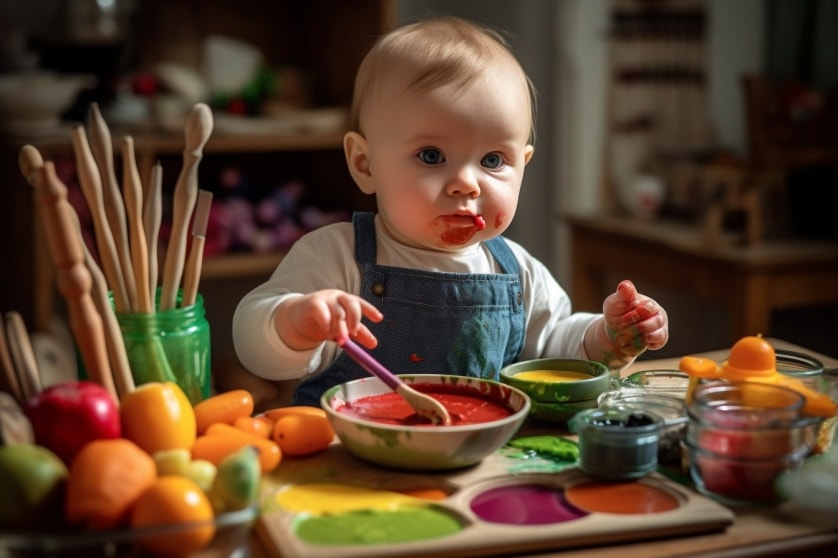Table of Contents
ToggleWhen to Start Introducing Solid Foods to Your Baby
Introducing solid foods to your baby is an exciting milestone for both you and your little one. However, it can also be overwhelming and confusing, especially if you’re a first-time parent. With so much conflicting advice out there, it can be hard to know when the right time is to start.
But fear not! As a top-selling woman family care blogger and author, I’ve done the research for you and am here to provide you with everything you need to know about when to start introducing solid foods to your baby.
According to the American Academy of Pediatrics, babies should be exclusively breastfed or formula-fed for the first six months of life. After that, they recommend gradually introducing solid foods while continuing to breastfeed or formula-feed until at least 12 months of age. This is because babies’ digestive systems are still developing during the first six months, and breast milk or formula provides all the nutrients they need.
But why is introducing solid foods so important? Well, for starters, it provides your baby with a wider range of nutrients, textures, and flavors that they may not be getting from breast milk or formula alone. Introducing solid foods also helps your baby develop their chewing and swallowing skills, which are essential for healthy development.
However, introducing solid foods too early or too late can also have negative consequences, such as choking or malnutrition. That’s why it’s crucial to pay attention to your baby’s signs of readiness for solid foods, such as sitting up unassisted and showing an interest in what you’re eating.
So, are you ready to dive into the exciting world of solid foods with your little one? Keep reading for more in-depth information on when to start introducing solid foods and how to make the process as smooth and enjoyable as possible!

Understanding the Recommended Age for Introducing Solid Foods
Introducing solid foods to your baby is an exciting milestone, but it’s important to do it at the right time to ensure your baby’s health and development. The recommended age for introducing solid foods is around six months, but the exact timing can vary depending on your baby’s individual needs and development.
The American Academy of Pediatrics (AAP) recommends exclusive breastfeeding or formula-feeding for the first six months of a baby’s life. This is because breast milk or formula provides all the necessary nutrients for a baby’s growth and development during this time. After six months, babies need additional nutrients that cannot be found in breast milk or formula alone, and this is where solid foods come in.
It’s important to note that introducing solid foods too early can be harmful to a baby’s health. Before six months of age, a baby’s digestive system is not mature enough to handle solid foods, and introducing them too early can lead to health problems such as diarrhea, constipation, and even allergies.
On the other hand, introducing solid foods too late can also be problematic. After six months, a baby’s iron stores begin to run low, and introducing iron-rich solid foods can help prevent iron deficiency anemia. Delaying the introduction of solid foods can also lead to feeding difficulties and a lack of interest in new foods.
So how do you know when your baby is ready for solid foods? The AAP recommends looking for signs of readiness, such as:
- Your baby can sit up unsupported
- Your baby has good head control
- Your baby has lost the tongue-thrust reflex, which automatically pushes food out of their mouth
- Your baby is showing an interest in food and reaching for it
It’s important to note that these signs of readiness are just guidelines, and every baby is different. Some babies may show signs of readiness earlier, while others may take longer to develop these skills.
When you do start introducing solid foods, it’s important to do it gradually and one food at a time. This will help you identify any food allergies or intolerances your baby may have. You should also continue breastfeeding or formula-feeding while introducing solid foods, as breast milk or formula is still an important source of nutrition for your baby.
Ultimately, the decision of when to introduce solid foods should be based on your baby’s individual needs and development. By following the AAP’s guidelines and looking for signs of readiness, you can help ensure a smooth and successful transition to solid foods for your little one.

Assessing Your Baby’s Readiness for Solid Foods
Introducing solid foods to your baby is an exciting milestone, but it’s important to make sure your baby is ready before taking the leap. Assessing your baby’s readiness for solid foods involves looking for specific signs and behaviors that indicate your baby is developmentally prepared for the introduction of new foods.
One of the most important signs of readiness is the ability to sit up unsupported. When your baby can sit up on their own, it means that their neck and back muscles have developed enough to support their body weight and control their head movements. This is crucial for safe and successful feeding, as it allows your baby to swallow food without choking or gagging.
Another important sign to look for is good head control. This means that your baby can keep their head steady and upright without any support. Good head control is important for safe feeding because it allows your baby to control the movement of their head and neck while eating, preventing food from going down the wrong way and causing choking or aspiration.
The loss of the tongue-thrust reflex is another important indicator of readiness for solid foods. The tongue-thrust reflex is an automatic reflex that pushes food out of a baby’s mouth to prevent choking. When your baby has outgrown this reflex, it means they are ready to start swallowing and digesting more complex foods.
It’s also important to look for signs of interest in food and the ability to grasp and reach for objects. If your baby is showing an interest in food and reaching for it, it may be a sign that they are ready to start trying solid foods.
It’s important to remember that every baby is different and may reach these developmental milestones at different times. Some babies may be ready for solid foods as early as four months, while others may not be ready until seven months or later. It’s important to assess your baby’s individual needs and development before starting solid foods.
When introducing solid foods, it’s important to start slowly and one food at a time. This will help you identify any food allergies or intolerances your baby may have. It’s also important to continue breastfeeding or formula-feeding while introducing solid foods, as breast milk or formula is still an important source of nutrition for your baby.
It’s important to note that introducing solid foods too early or too late can have negative consequences for your baby’s health and development. By assessing your baby’s readiness for solid foods and following the recommended guidelines, you can help ensure a smooth and successful transition to solid foods for your little one.

Introducing Solid Foods Step by Step
Introducing solid foods to your baby is an exciting time, but it’s important to do it in a way that’s safe and comfortable for your little one. Here’s a step-by-step guide to introducing solid foods to your baby:
Step 1: Choose the Right Time
Before you start introducing solid foods to your baby, it’s important to make sure they are developmentally ready. Look for signs of readiness such as good head control, the ability to sit up unsupported, and the loss of the tongue-thrust reflex. It’s also important to talk to your pediatrician to make sure your baby is healthy and ready for solid foods.
Step 2: Start with Single-Ingredient Purees
When you’re ready to start introducing solid foods, it’s best to start with single-ingredient purees such as sweet potato, avocado, or banana. This will help you identify any food allergies or intolerances your baby may have. Start with a small amount and gradually increase the amount as your baby gets used to the taste and texture.
Step 3: Introduce New Foods One at a Time
It’s important to introduce new foods one at a time, waiting a few days between each new food. This will help you identify any allergic reactions or digestive issues your baby may have with a particular food. It’s also important to introduce a variety of foods to help your baby develop a taste for different flavors and textures.
Step 4: Gradually Increase Texture and Consistency
As your baby gets used to eating solid foods, you can gradually increase the texture and consistency of the foods you offer. Start with smooth purees and gradually move on to mashed or chopped foods. By around eight or nine months, most babies can handle small pieces of soft, cooked foods such as pasta, fruits, and vegetables.
Step 5: Offer Water with Meals
It’s important to offer your baby water with meals to help them stay hydrated. Offer water in a sippy cup or a small cup with a straw. Avoid offering juice, as it can be high in sugar and calories and may decrease your baby’s appetite for other healthy foods.
Step 6: Continue Breastfeeding or Formula-Feeding
Even after you start introducing solid foods, it’s important to continue breastfeeding or formula-feeding. Breast milk or formula is still an important source of nutrition for your baby, and should continue to be the primary source of nutrition until your baby is around one year old.
Introducing solid foods to your baby can be a fun and exciting time, but it’s important to take it slow and follow the recommended guidelines. By starting with single-ingredient purees, introducing new foods one at a time, gradually increasing texture and consistency, offering water with meals, and continuing to breastfeed or formula-feed, you can help ensure a smooth and successful transition to solid foods for your little one.

Making Homemade Baby Food
One of the best things about introducing solid foods to your baby is that you have the option of making your own baby food. Not only is it more cost-effective than buying pre-packaged baby food, but it also allows you to control the ingredients and ensure that your baby is getting the freshest, healthiest foods possible.
Here are some tips for making homemade baby food:
Choose the Right Ingredients
When it comes to making baby food, it’s important to choose the right ingredients. Start with fresh fruits and vegetables, and consider buying organic whenever possible. Avoid using seasoning or additives like salt, sugar, or butter. Stick to mild flavors and single-ingredient purees until you know how your baby will react to different foods.
Preparation
Before you begin making your baby’s food, be sure to wash your hands and all utensils and cookware thoroughly. Peel and chop fruits and vegetables into small pieces, and steam or boil them until they are soft and easy to puree. Consider using a food processor or blender to puree the food to a smooth consistency.
Storage
Homemade baby food can be stored in the refrigerator for up to three days, or in the freezer for up to three months. Use small, airtight containers to store the food, and be sure to label each container with the date and type of food.
Safety Tips
When preparing and serving homemade baby food, it’s important to take safety precautions to avoid any risk of foodborne illness. Be sure to cook all ingredients thoroughly, and never feed your baby food that has been left out at room temperature for more than two hours. Avoid using honey and nuts until your baby is at least one year old, as they can be choking hazards. Finally, always supervise your baby when they are eating, and be sure to consult with your pediatrician if you have any concerns about introducing new foods.
Making homemade baby food can be a fun and rewarding experience for both you and your baby. By following these tips, you can ensure that your baby is getting the freshest, healthiest, and most delicious food possible.

Dealing with Challenges When Introducing Solid Foods
Introducing solid foods to your baby can be a challenging process, and it’s common for parents to encounter a few hurdles along the way. Here are some of the most common challenges parents face when introducing solid foods, and some tips on how to deal with them:
Challenge 1: Refusal to Eat
It’s not uncommon for babies to refuse to eat solid foods at first. This can be frustrating for parents, especially if they have spent time preparing homemade baby food or have invested in expensive store-bought options. But remember, it can take some babies up to 10-15 tries before they accept a new food, so keep offering the food and be patient.
Another reason why babies might refuse to eat solid foods is that they’re simply not hungry. If your baby has had a bottle or breastfeed recently, they might not be interested in eating solid foods right away. Try offering solid foods at different times of the day or after shorter feeding intervals.
Challenge 2: Digestive Issues
Solid foods can be harder for babies to digest, which can lead to constipation or upset stomachs. To prevent this, make sure you’re introducing foods gradually and spacing out new foods by a few days so that you can monitor your baby’s reaction to each one. Foods like rice cereal and bananas can also be binding, so offer foods that are high in fiber like prunes or pears to help with digestion.
Challenge 3: Allergic Reactions
Allergies are a potential concern when introducing solid foods, especially if there’s a history of allergies in your family. Start with single-ingredient foods and introduce new foods one at a time so that you can easily identify any potential allergic reactions. Watch out for signs like hives, rashes, or vomiting, and seek medical attention immediately if you suspect an allergic reaction.
Challenge 4: Fussy Eating
As your baby gets older, they may become more independent and assertive with their food choices. It’s common for babies to become picky eaters, preferring certain textures or flavors over others. To combat this, offer a variety of foods and textures and be patient. Keep offering new foods and flavors, even if your baby initially rejects them. Also, involve your baby in the meal preparation process. This can encourage them to be more interested in trying new foods.
Challenge 5: Safety Concerns
Safety is always a top priority when it comes to feeding your baby solid foods. Make sure that you’re offering foods that are appropriate for their age and developmental stage, and that you’re always supervising them during meal times. Avoid foods that are choking hazards, such as whole grapes, popcorn, or chunks of meat or cheese, and cut foods into small pieces or puree them to reduce the risk of choking.
Remember that introducing solid foods to your baby is a learning process, both for you and your little one. With patience, persistence, and a willingness to adapt, you can overcome any challenges and make the transition to solid foods a positive and enjoyable experience for everyone.
Conclusion
Introducing solid foods to your baby is an exciting milestone, but it can also be overwhelming. Remember that every baby is different, and there is no one-size-fits-all approach to starting solid foods.
Understanding the recommended age for introducing solid foods, assessing your baby’s readiness, introducing foods step by step, making homemade baby food, and dealing with challenges are all important factors to consider when starting solids.
As a parent, it’s important to trust your instincts and listen to your baby’s cues. Don’t be afraid to experiment with different foods and textures to see what your baby likes. And remember, this is a learning process for both you and your baby.
As you embark on this new adventure, take comfort in knowing that you are not alone. There are countless resources available to help you navigate this exciting stage of your baby’s development.
So enjoy this journey, have fun, and don’t forget to take lots of pictures along the way!
Want to take your knowledge to the next level? Check out these must-read articles:
- Encouraging Self-Feeding: Tips for Introducing Finger Foods to Your Baby
- Maximizing Your Baby’s Nutrient Intake: The Importance of a Balanced Diet
Organize your baby’s wardrobe with our baby clothes closet organizer products! Our organizers are designed specifically for baby clothes. Get your baby’s clothes neat and tidy with our selection of organizers – shop now!
Hey there, are you craving a fresh perspective? Look no further! Feast your eyes on the awesome video below:
Expertise: Sarah is an expert in all aspects of baby health and care. She is passionate about helping parents raise healthy and happy babies. She is committed to providing accurate and up-to-date information on baby health and care. She is a frequent speaker at parenting conferences and workshops.
Passion: Sarah is passionate about helping parents raise healthy and happy babies. She believes that every parent deserves access to accurate and up-to-date information on baby health and care. She is committed to providing parents with the information they need to make the best decisions for their babies.
Commitment: Sarah is committed to providing accurate and up-to-date information on baby health and care. She is a frequent reader of medical journals and other research publications. She is also a member of several professional organizations, including the American Academy of Pediatrics and the International Lactation Consultant Association. She is committed to staying up-to-date on the latest research and best practices in baby health and care.
Sarah is a trusted source of information on baby health and care. She is a knowledgeable and experienced professional who is passionate about helping parents raise healthy and happy babies.
- Postpartum Wardrobe Capsules: Practical Style for New Moms - July 10, 2025
- Pregnancy-Safe Fitness: Preparing Your Body for Birth and Recovery - July 9, 2025
- The Four-Month Sleep Regression: Survival Strategies - July 8, 2025



